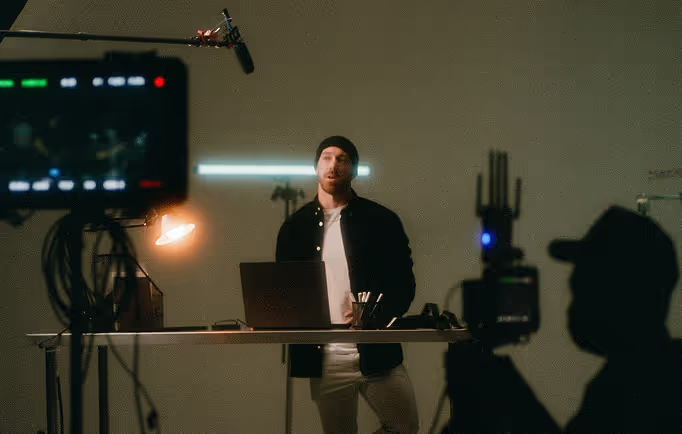So… What Actually Is Paid Media?: The What, Why, And How Of Paid Video Advertising

Last time we took a step into the world of paid video advertising through the lens of niche audience targeting. This time we’re back for a deep (but totally swimmable) dive on the topic to understand what paid video advertising actually means within the social media landscape, why paid media is so important to your video campaign, and some best practices for developing video in the paid social media marketplace.
1) what does paid video advertising actually mean (and what doesn’t it mean)?
The PESO model splits advertising and distribution of media materials into four categories: owned media, earned media, shared media and paid media (https://spinsucks.com/communication/pr-pros-must-embrace-the-peso-model/).
Here’s the quick low down: Owned media involves primary content that your brand, you guessed it, owns. This content is created specifically by and/or for your brand and lives on owned platforms like your website or blog. Earned media is traditionally considered the realm of PR – journalism and media coverage ‘earned’ for building relationships with other media outlets and creating interesting promotable content – but in the modern day has expanded to include influencer promotions and link building. Shared media refers to organic audience spread and community engagement, including any fan-made content, social media sharing amongst users, and unsolicited reviews. Finally, paid media is of course the paid advertising, the boosted posts, and the sponsored content – using paid avenues to hit particular areas of the market. Ideally, your video advertising is working synergetically through all four sectors of the PESO model.
In today’s online market the line between paid and earned, earned and shared, shared and owned, and paid and owned media is increasingly blurry. As the methods for online communication get faster and tighter, each segment feeds into each other in cycles, sometimes regurgitating media in new and unexpected ways as the borders are crossed. This happens more and more frequently with short-form videos: a paid video advertisement gets memefied through social sharing; an influencer promotes a video which triggers an influx of journalistic earned promotion; a fan creation of an existing intellectual property becomes popular through sharing, gains earned media coverage, then eventually is reworked enough to become its own separate owned media.
2) why should we pay to advertise video content?
With the existence of owned, earned and shared marketing streams which can sometimes cost little to nothing to generate, it can be easy to question why big brands opt to use paid advertising at all. When it comes down to it, the key appeal of using paid media as distinct from the other PESO segments is in intentional and controlled audience targeting. Unlike owned media, you are proactively seeking out your target audience instead of waiting for them to find you. And unlike earned or shared media, you have a relative level of control over where your content ends up and, therefore, whose eyes end up watching it.
The latest trend in paid video advertising on social media platforms is native advertising – essentially this is where paid media is designed to blend in with the surrounding content as seamlessly as possible. Sometimes this is through promoted posts, which look and feel like the other posts on a user’s social media feed but are paid to be targeted toward user groups with specific demographics or interests. Other times it can take the form of sponsored content, which presents interesting content about a related topic without being directly about the advertising brand.
The advantage of using this kind of paid native advertising is covered in-depth in our previous article on How Paid Video Advertising Targets Your Niche Market (https://www.explanimate.com.au/how-paid-video-advertising-targets-your-niche-market/). TLDR; By creating video content the audience is already primed to see on whatever social platform you’re targeting, they are more likely to engage, less likely to skip, and more easily able to lower their defence toward advertising content. Be the thing your audience wants to see.
3) how can we use paid video advertising for the greatest chance of success?
When developing video content with an intent for paid video advertising (and especially native advertising), it’s important to be thoroughly aware of how it will fit in to your targeted social platform. This goes way beyond basic technical specifications of using the right dimensions, ratio, and compression. If you want to meet your target audience where they are (which is really the whole point of paid video advertising), you need to understand the style, voice, and mood of the place you’re meeting them. Online advertising sticks out like a sore thumb when it fails to be compatible with the ethos of the website it’s appearing on – just like you don’t show up to a funeral in a speedo, and you don’t show up to McDonald’s in a wedding dress (or maybe you do, I don’t know your life and/or your unnatural affection for Big Macs). Paid media on Facebook is extremely different to paid media on Reddit, which is extremely different to paid media on TikTok, so it’s important to understand the ‘unwritten social rules’ of your target platform when developing your video script and visual style to avoid unnecessary faux pas.
But above this, don’t be afraid to go a little left field of the usual social media style if it means connecting more directly with your specific target audience. Integrated A/B testing is supported on many (if not most) social media ad decks nowadays, so there’s room to try slightly different videos to really nail down your approach before deciding on a final design for a wider paid audience.
Lastly, paid video advertising is most effective when it works in tandem with the other elements of the PESO model, so be prepared with steps for action if and when your paid video jumps ship through viewer sharing, reviews, and unexpected media coverage. The paid, shared, earned, and owned avenues for video publishing in the social media landscape are increasingly interconnected, and it’s in your best interests to have a strong presence in and between each of them.
Start a






